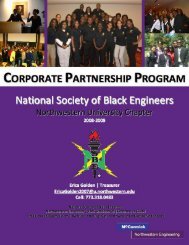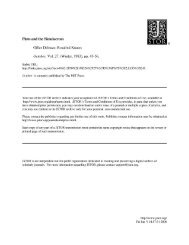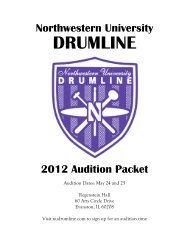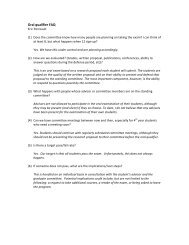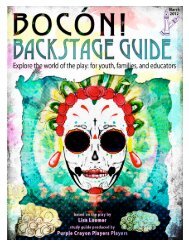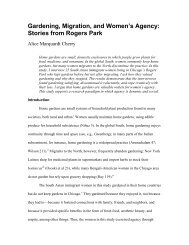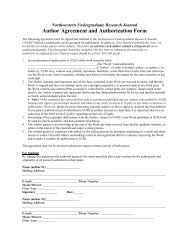research - Associated Student Government, Northwestern University
research - Associated Student Government, Northwestern University
research - Associated Student Government, Northwestern University
Create successful ePaper yourself
Turn your PDF publications into a flip-book with our unique Google optimized e-Paper software.
ABSTRACTRight and left lengths of the humerus, radius, femur,and tibia were recorded for 308 archaeologicalsamples. Percent differences between the sameclass of bones on the left and right sides of the bodywere calculated for each individual. These percent differenceswere used as measures of the degree of asymmetryfor each bone. Individuals were separated by ageand sex in order to analyze whether skeletal symmetrychanges over growth and development and whethermales and females are equally asymmetrical.Statistical analysis of asymmetry patterns produceda number of interesting conclusions. Results indicatethat infants are symmetrical. I contend that this is dueto the fact that infants are less likely to demonstratethe effects of environmental insult as compared to individualsfrom older age categories because they areless subject to strenuous, unimanual tasks, disease, andfood shortages. For example, infants have a consistentsource of food in the form of antibody-laden breastmilk which also helps to ward off disease (Owsley andJantz 1985). In turn, children exhibit fluctuating asymmetrywhile adolescents and adults exhibit directionalasymmetry. Childhood is a period of significant growth.When this period is interrupted by disease and malnutrition,fluctuating asymmetry appears in the skeleton.The directional asymmetry seen in adolescent and adultsamples is the result of consistent and intense physicaland/or cultural activities that stress one side of the body(Blackburn 2011). Adult Arikara females are moreasymmetric on average in upper limb bones (humerusand radius) than adult males. This is attributed togreater adult Arikara female involvement in agricultureand manufacturing tasks. A cross-cultural comparisonwas also performed between Arikara and ancestral NewMexico Puebloan remains. Adult male Arikara exhibitmore asymmetric humeri than adult male Puebloanswhile adult female Arikara exhibit more asymmetrichumeri than their adult female Puebloan counterparts.These results indicate that adult Arikara men and womenengaged in more stressful, unimanual activities thantheir respective ancestral Puebloan counterparts.This <strong>research</strong> is significant to the fields of physicaland biological anthropology because it builds upon thescience of skeletal and muscular change due to environmentalstress. By documenting bodily asymmetryand the environmental conditions in which it is seen,this study sheds light upon the external conditions thatinduce human skeletal variation. Also, this <strong>research</strong> issignificant to archaeology. Archaeologists who employskeletal analysis to examine body use patterns and theirassociations with distinct work environments will findthis work useful in establishing connections betweenculture and biology.Literature CitedBlackburn A. 2011. Bilateral Asymmetry of the Humerus During Growth and Development.American Journal of Physical Anthropology 145(4):639-646.Leung B, Forbes MR, and Houle D. 2000. Fluctuating asymmetry as a bioindicator of stress:Comparing efficacy of analyses involving multiple traits. American Naturalist 155(1):101-115.Owsley DW, and Jantz RL. 1985. Long-Bone Lengths Gestational-Age Distributions ofPost-Contact Period Arikara Indian Perinatal Infant Skeletons. American Journal ofPhysical Anthropology 68(3):321-328.Palmer AR. 1994. Fluctuating Asymmetry Analyses: A Primer. In: Markow TA, editor.Developmental Instability: Its Origins and Evolutionary Implications. Kluwer, Dordrecht,Netherlands. p 335-364.West-Eberhard M. 2005. Phenotypic Accommodation: Adaptive Innovation Due toDevelopmental Plasticity. Journal of Experimental Zoology 304B:610-618.VOLUME 7, 2011-2012NORTHWESTERN UNDERGRADUATE RESEARCH JOURNAL27



